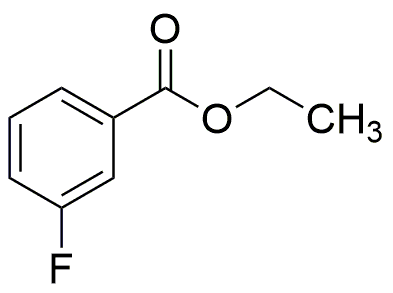Ethyl 3-fluorobenzoate is widely utilized in research focused on:
- Synthetic Organic Chemistry: This compound serves as a key intermediate in the synthesis of various pharmaceuticals and agrochemicals, enabling researchers to develop new drugs and crop protection agents efficiently.
- Fluorine Chemistry: Its unique fluorine atom enhances the reactivity and stability of compounds, making it valuable in the design of novel materials and fine chemicals, particularly in the electronics and materials science industries.
- Biological Studies: Ethyl 3-fluorobenzoate is used in biological research to explore the effects of fluorinated compounds on biological systems, aiding in the understanding of drug interactions and mechanisms.
- Polymer Chemistry: This chemical is employed in the development of fluorinated polymers, which exhibit superior chemical resistance and thermal stability, making them ideal for applications in coatings and advanced materials.
- Analytical Chemistry: It is utilized as a reference standard in analytical methods, such as chromatography, helping researchers ensure accurate identification and quantification of similar compounds in complex mixtures.
General Information
Properties
Safety and Regulations
Applications
Ethyl 3-fluorobenzoate is widely utilized in research focused on:
- Synthetic Organic Chemistry: This compound serves as a key intermediate in the synthesis of various pharmaceuticals and agrochemicals, enabling researchers to develop new drugs and crop protection agents efficiently.
- Fluorine Chemistry: Its unique fluorine atom enhances the reactivity and stability of compounds, making it valuable in the design of novel materials and fine chemicals, particularly in the electronics and materials science industries.
- Biological Studies: Ethyl 3-fluorobenzoate is used in biological research to explore the effects of fluorinated compounds on biological systems, aiding in the understanding of drug interactions and mechanisms.
- Polymer Chemistry: This chemical is employed in the development of fluorinated polymers, which exhibit superior chemical resistance and thermal stability, making them ideal for applications in coatings and advanced materials.
- Analytical Chemistry: It is utilized as a reference standard in analytical methods, such as chromatography, helping researchers ensure accurate identification and quantification of similar compounds in complex mixtures.
Documents
Safety Data Sheets (SDS)
The SDS provides comprehensive safety information on handling, storage, and disposal of the product.
Product Specification (PS)
The PS provides a comprehensive breakdown of the product’s properties, including chemical composition, physical state, purity, and storage requirements. It also details acceptable quality ranges and the product's intended applications.
Certificates of Analysis (COA)
Search for Certificates of Analysis (COA) by entering the products Lot Number. Lot and Batch Numbers can be found on a product’s label following the words ‘Lot’ or ‘Batch’.
*Catalog Number
*Lot Number
Certificates Of Origin (COO)
This COO confirms the country where the product was manufactured, and also details the materials and components used in it and whether it is derived from natural, synthetic, or other specific sources. This certificate may be required for customs, trade, and regulatory compliance.
*Catalog Number
*Lot Number
Safety Data Sheets (SDS)
The SDS provides comprehensive safety information on handling, storage, and disposal of the product.
DownloadProduct Specification (PS)
The PS provides a comprehensive breakdown of the product’s properties, including chemical composition, physical state, purity, and storage requirements. It also details acceptable quality ranges and the product's intended applications.
DownloadCertificates of Analysis (COA)
Search for Certificates of Analysis (COA) by entering the products Lot Number. Lot and Batch Numbers can be found on a product’s label following the words ‘Lot’ or ‘Batch’.
*Catalog Number
*Lot Number
Certificates Of Origin (COO)
This COO confirms the country where the product was manufactured, and also details the materials and components used in it and whether it is derived from natural, synthetic, or other specific sources. This certificate may be required for customs, trade, and regulatory compliance.


